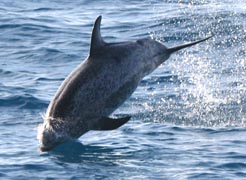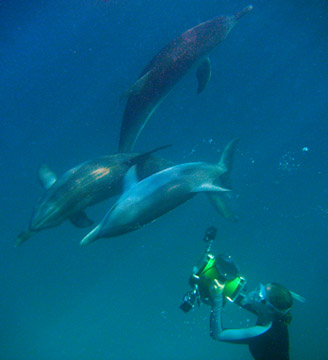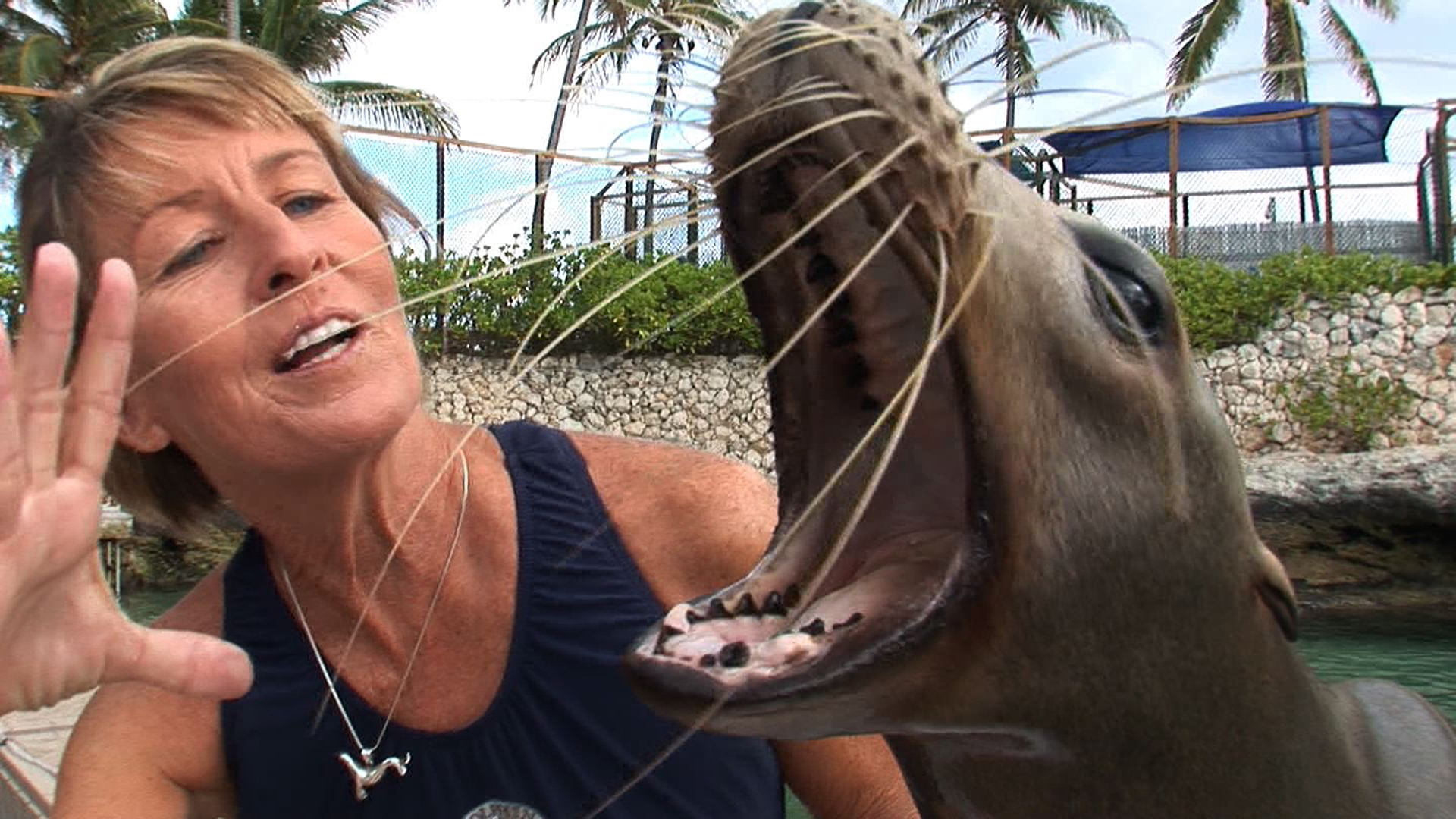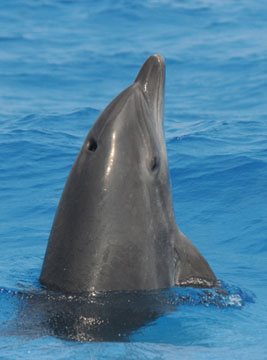Field Course for Marine Mammal Trainers Overview
What is it?
A week-long course that combines lectures on marine mammal behavior and cognition, cetacean ecology, observational research methods, and boat-based and in-water encounters with wild Atlantic spotted dolphins near Bimini and common bottlenose dolphins in human care at Dolphin Encounters in Nassau.
Who’s it for?
This course is specially designed for marine mammal trainers at any stage in their career, and hailing from any country or facility around the world. The course offers opportunities to participate in field research and exchange ideas and information with peers. We are also pleased to accept upper-level university students and recent graduates who are interested in marine mammal research and training careers.
Where is it located?
The course will take place at two locations in The Bahamas: Bimini, a small island around which groups of wild Atlantic spotted and bottlenose dolphins frequent, and at Dolphin Encounters in Nassau, a locally-owned natural seawater facility home to bottlenose dolphins and sea lions.
When is the course?
The course is scheduled for 15 – 22 September 2013. Space will be available for approximately ten (10) trainers and students.
 Course Goals
Course Goals
Deeper Understanding
Opportunities for directly observing the natural behavior of wild dolphins are rare. This course offers participants a unique chance to observe Atlantic spotted and bottlenose dolphins socializing, feeding, playing, etc. in their natural environment via boat-based and in-water encounters near Bimini, The Bahamas. The course provides a comprehensive overview of the behavior and ecology of these animals. An added benefit is participation in DCP’s ongoing comparative research of wild and captive dolphin communication.
Research Skills
Lead by a team of researchers with experience studying both wild and captive dolphins using a non-invasive observational protocol, participants will learn how to conduct basic observational research from experienced scientists working with the Dolphin Communication Project. Participants will learn about photo-ID, acoustic and video analysis, the scientific method, the role of ethograms, and ethology research methods. Participants will have an active role in research conducted by DCP scientists at both study sites.
Knowledge Integration
Having observed some of the wild behaviors upon which their own training techniques are based, and having gained an appreciation for the methods used by scientists studying dolphins in the wild, trainers who complete this course will be better equipped to share their enthusiasm and knowledge of marine mammal behavior with both guests and colleagues at their home institutions. These trainers will gain direct experience in ongoing, active research.
Bimini
Bimini
The island, or more accurately islands, of Bimini lie less than 50 miles off the east coast of Florida. Bimini is just a 20 minute plane ride from the U.S. Only a few hundred yards wide in some areas, Bimini is known for fishing, SCUBA diving and, of course, dolphins.
The Water
Bimini lies at the northwestern edge of the Great Bahama Bank, a vast area of warm, shallow water over a sandy seafloor. Portions of the island are made up of intricate mangrove systems, which in addition to great kayaking, are home to dozens of juvenile fish species. This important nursery ground is thought to be the source for many of the fish that grow up to populate other areas of The Bahamas. Immediately to the west of Bimini, and in stark contrast to the Great Bahama Bank, is the Gulf Stream (aka Florida Straights). The waters swiftly flowing north through this deep ocean trench provide a constant supply of “fresh” water and nutrients to the area, including fish such as mackerel and mahi mahi. It is thought that the dolphins around Bimini spend the majority of their time in the relative safety of the bank, while cruising out to deep water to feed.
The Dolphins
The group of Atlantic spotted dolphins (Stenella frontalis) studied by DCP off the coast of Bimini are thought to be resident animals – meaning that each individual is born and raised, has its own calves and lives out the entirety of its life in the waters immediately surrounding Bimini. Although spotted dolphins are born without spots, they can be recognized by their individual spot pattern, which begins to develop around the age of 3 or 4 years. By documenting individuals through photographs and video, we can track the population over time and confirm that we do see the same individuals year after year. Since the animals develop new spots throughout their entire lives, it is important that DCP researchers are able to document as many individuals as possible each year.
There are also common bottlenose dolphins (Tursiops truncatus) found off the coast of Bimini. Members of this species are recognized by nicks in their dorsal fins, which are photographed as the animal breaks the surface to breathe. These photographs are supplemented with full body images from underwater video when possible. There does appear to be some residency pattern among what may be “coastal” bottlenose dolphins. It is also likely that there is an “offshore” bottlenose group, however their exact composition and interaction with the coastal dolphins is not known at this time.
Dolphin Encounters
Dolphin Encounters is located on Blue Lagoon Island, a short ferry ride from Paradise Island. Dolphin Encounters Ltd. is a member of the International Marine Animal Trainers Association (IMATA) and the Alliance of Marine Mammal Parks and Aquariums. During its short history, Dolphin Encounters has transformed itself from a dolphin rescue project with two dolphins and three employees to one of Nassau’s foremost tourist attractions with bottlenose dolphins, sea lions and over 150 dedicated staff.
Course Structure
Lecture Topics*
Wild dolphin behavior and ecology
Dolphin communication and cognition
Introduction to the coastal ecology and dolphins of Bimini, The Bahamas
Scientific method and observational research: techniques & applications
Boat based surveys & DCP’s mobile video acoustic array
Photo-identification of cetaceans & video analysis
Behavioral ethograms: application to Bimini’s dolphins
Eco-tourism: finding the balance
Comparing wild vs. captive dolphin behavior
*exact topics subject to change
Course Structure
Approximate times are listed according to content for a tentative daily schedule.
The 2013 program begins on 15 September in Bimini and concludes the morning of 22 September in Nassau.
Day 1 – Bimini, Bahamas
12:00 Arrive on Bimini
13:00 Orientation & Lunch
15:30-19:30 Wild Dolphin Survey
Day 2 – Bimini, Bahamas
9:00-11:00 Lecture/Discussion
12:30-14:30 Lecture/Discussion
15:30-19:30 Wild Dolphin Survey
Day 3 – Bimini, Bahamas
9:00-10:30 Lecture/Discussion
11:00-12:00 Lecture/Discussion
13:00-14:00 Lecture/Discussion
15:30-19:30 Snorkeling & Wild Dolphin Survey
Day 4 – Bimini, Bahamas
9:00-11:00 Lecture/Discussion
11:00-12:30 Review materials/write papers/journals
15:30-19:30 Snorkeling & Wild Dolphin Survey
20:30-21:30 Evening Discussion
Day 5 – Bimini, Bahamas
9:00-12:30 Lecture/Discussion
15:30-19:30 Wild Dolphin Survey
19:30 to 20:30 Film Night
Day 6 – Dolphin Encounters, Nassau, Bahamas
9:00: Travel to Nassau, get to lodging, settle in
13:00-15:00 Introduction to DCP and DE
19:00-21:00 Evening Discussion
Day 7 – Dolphin Encounters, Nassau, Bahamas
9:00-17:00 Programs & content at DE
19:30-21:00 Evening Discussion
Day 8 – Dolphin Encounters, Nassau, Bahamas
Program Concludes
Participants Depart Nassau
Activities
Daily Activities on Bimini
Field work on Bimini generally consists of 4-5 hour boat trips in a pre-designated survey area. Lecture topics are covered in the morning and early afternoon, with boat surveys completed in the afternoon. Lectures will be provided by DCP researchers: Kelly Melillo-Sweeting, Kathleen Dudzinski, and/or Justin Gregg. A list of suggested primary literature can be provided as reading material for each topic.
While on-board the survey vessel, participants will be responsible for posted watches, data sheets, GPS operation, etc. Once dolphins are in view, participants will need to note depth, species, group size and composition, behaviors and known individuals. If the group is able to make underwater observations, participants will be in pairs (for safety and cooperative learning) and will rotate the use of underwater slates, video camera and digital still cameras. Two participants may be required to stay onboard the vessel in order to note surface observations. Participants may be required to assist with daily cleaning of the vessel at the end of each day. Participants will then be assigned the task of identifying the dolphins in their still photographs or slate sketches, either in pairs or as group, as photographs and time allow. These photographs will contribute to DCP’s photo-ID catalog. The DCP research leader will be participating in underwater observations and recording video and acoustic data with the MVA system.
Dolphin Ecounters Excursion
While at Dolphin Encounters in Nassau, course participants will have the opportunity to visit the facility and meet and interact with facility staff, including local trainers. Participants will learn how the Dolphin Communication Project conducts observational research with captive animals at Dolphin Encounters.
Course Logistics: Bimini
The Boat
A42’ Hatteras accommodates 10-18 passengers, including DCP researchers. This boat is locally owned and operated. Our captain has over 20 years experience on the waters of Bimini.
Lodging
Sea Crest Hotel and Marina is locally owned and operated. The “suite” includes cooking and living space and is suitable for meals and teaching. Additional hotel rooms will be added to supplement sleeping space. Standard hotel rooms have two double beds, ensuite bathroom, A/C, fresh water showers, and TV.
Travel
Flights to South Bimini (BIM) originate in Ft. Lauderdale/Hollywood International (FLL) or Nassau, The Bahamas (NAS). Travel through FLL is common, particularly if scheduling requires a night’s layover to catch the morning flight to Bimini as hotels near FLL with complimentarly shuttle service abound. United Airlines (operated by Silver) is recommended. The US$25.00 Bahamian departure tax is included in United Airline tickets. Western Air offers daily (a.m.) service from Nassau to Bimini, although NAS does not offer “airport hotels;” if a layover is required, lodging must be secured away from the airport. Please check with United and/or Western at the time of booking for baggage allowances and other restrictions. Most citizens are required to travel with a valid passport, but all participants should confirm entry requirements. North Bimini is a short taxi (land and water) ride from the South Bimini airport. These services run regularly and are included in the course fee.
Food
Family-style meals are included in your course fee. In Bimini, participants will assist in daily meal preparation and clean-up. Drinking water as well as a snack during each boat trip are provided in Bimini. Special dietary needs can be accommodated, however DCP must be informed of these at the time of registration.
Weather Conditions
Weather patterns in Bimini can be unpredictable. During the summer, sea conditions tend to be consistently more favorable, but the risk of major storms increases. There are no refunds for boat trips cancelled due to weather, however every effort will be made to offer alternative, active learning experiences.
Dolphin Sightings
The Atlantic spotted and bottlenose dolphins off Bimini, The Bahamas are wild. Therefore, there is no guarantee that we will see dolphins, however the sighting success rate has been between 80-90% since 2003. Participants will be exposed to the challenges of weather and subject dependent field work.
Money
In The Bahamas (both Bimini & Nassau), the national currency is the Bahamian Dollar; however, U.S. dollars are accepted at a 1:1 ratio. There is a single ATM on Bimini and it is located on the hotel’s property. Only large merchants will accept credit cards (MasterCard and Visa); small vendors only take cash.
Fees
Course fees include the following
7 nights’ accommodation (up to quad occupancy)
3 meals/day (final dinner in Nassau not included)
Drinking water (Bimini)
Boat snack (Bimini)
5 dolphin surveys (weather dependent)
Bimini airport/hotel transfers
Nassau (Day 6 only) airport/hotel transfer
Air travel from Bimini to Nassau (one way on Day 6)
1 day at Dolphin Encounters
DCP facilitation fee
Total: $1,970* per person
*air travel is NOT included, except on Day 6
The course requires a minimum of 8 participants, maximum of 10-12.
For advice on booking flights to/from Bimini and Nassau, please contact DCP.
One-way travel from FLL to BIM is approximately $175 – 215.
One-way travel from NAS to BIM is approximately $90.
All fees listed are in US dollars.
